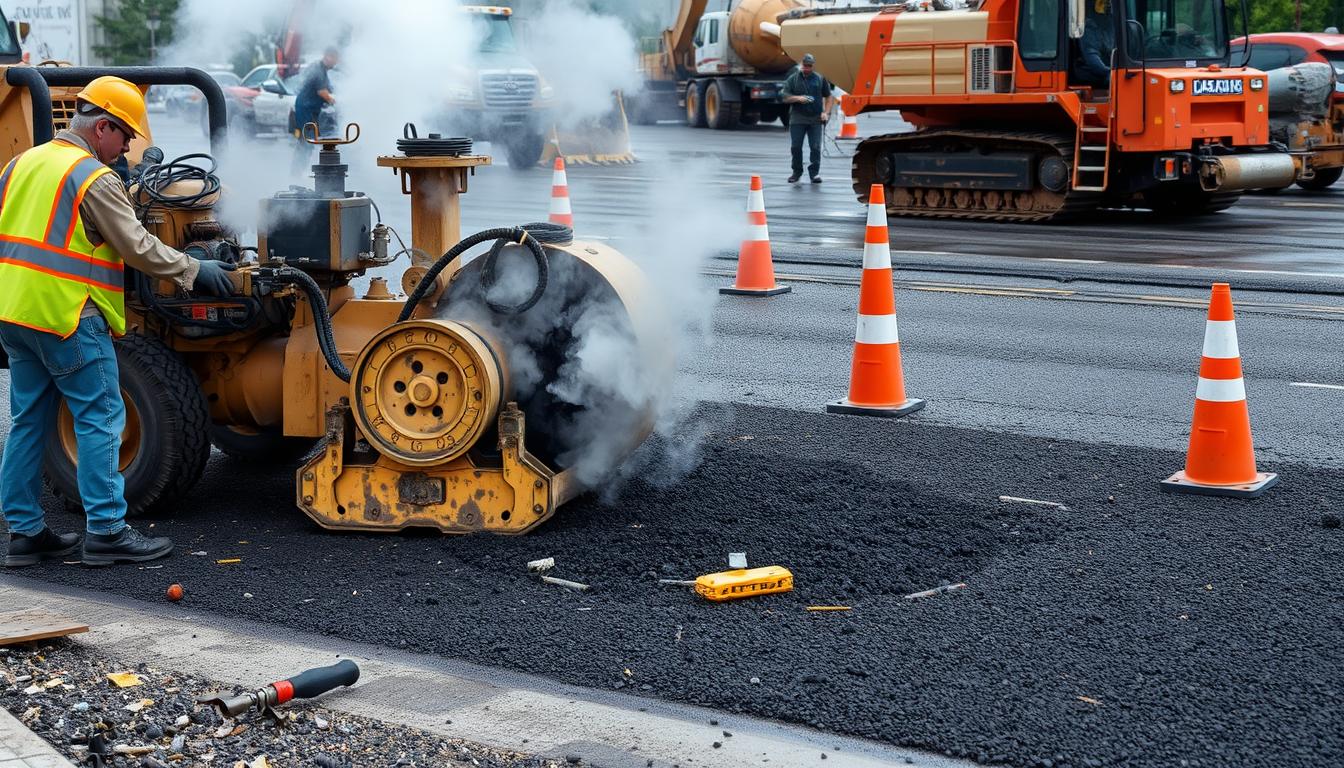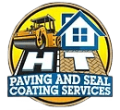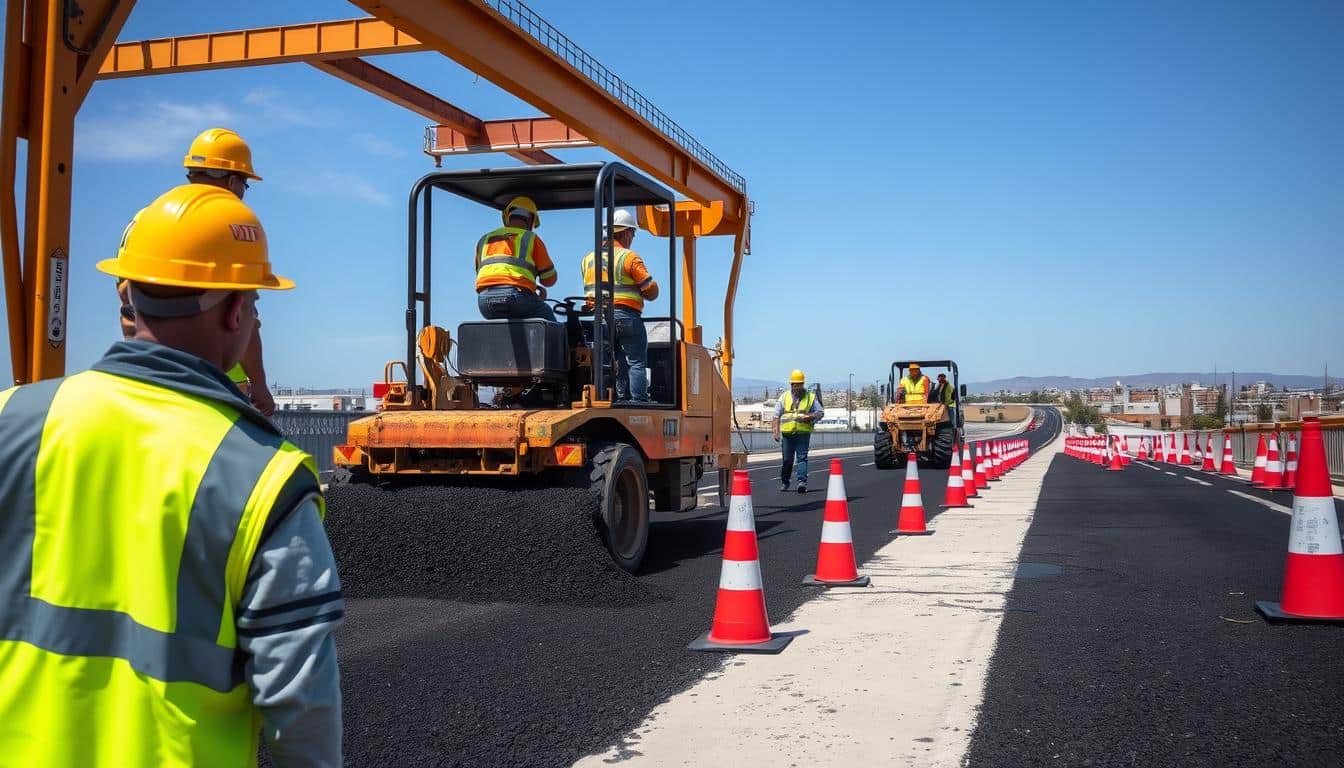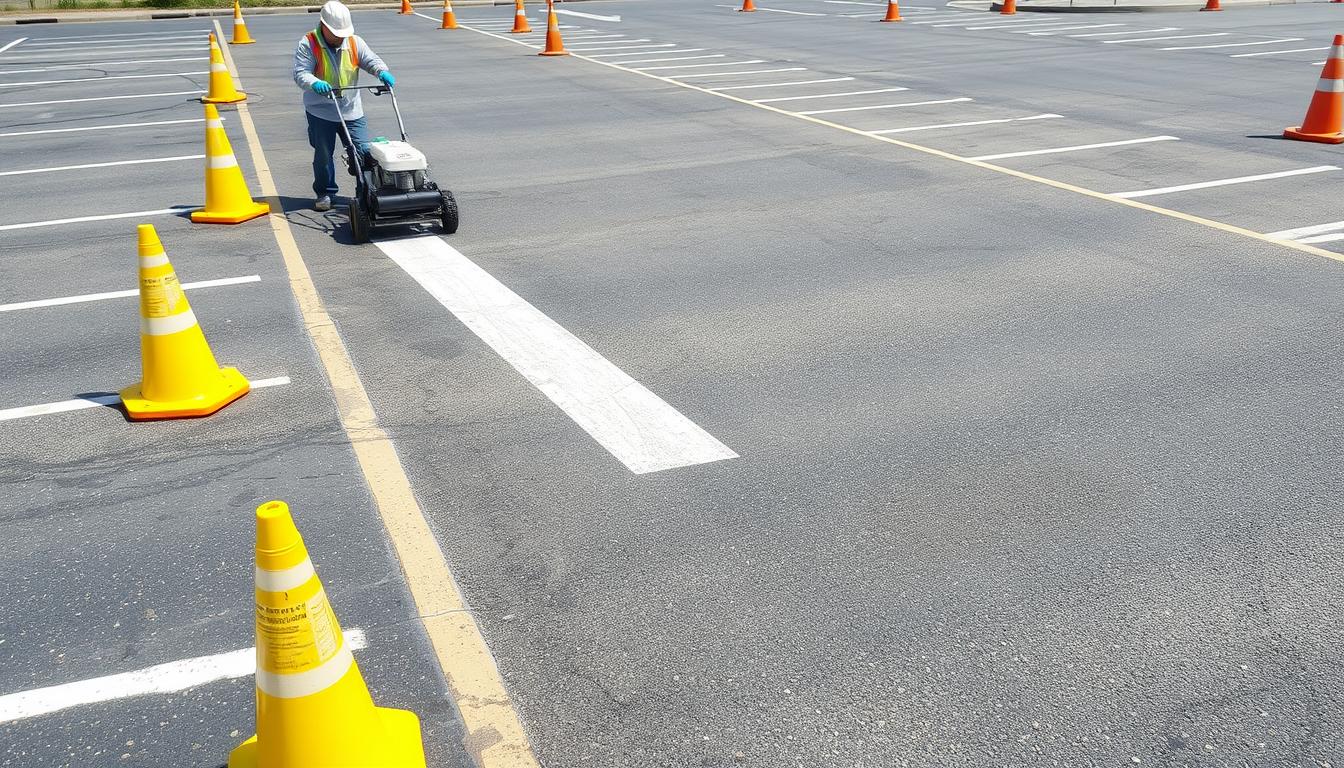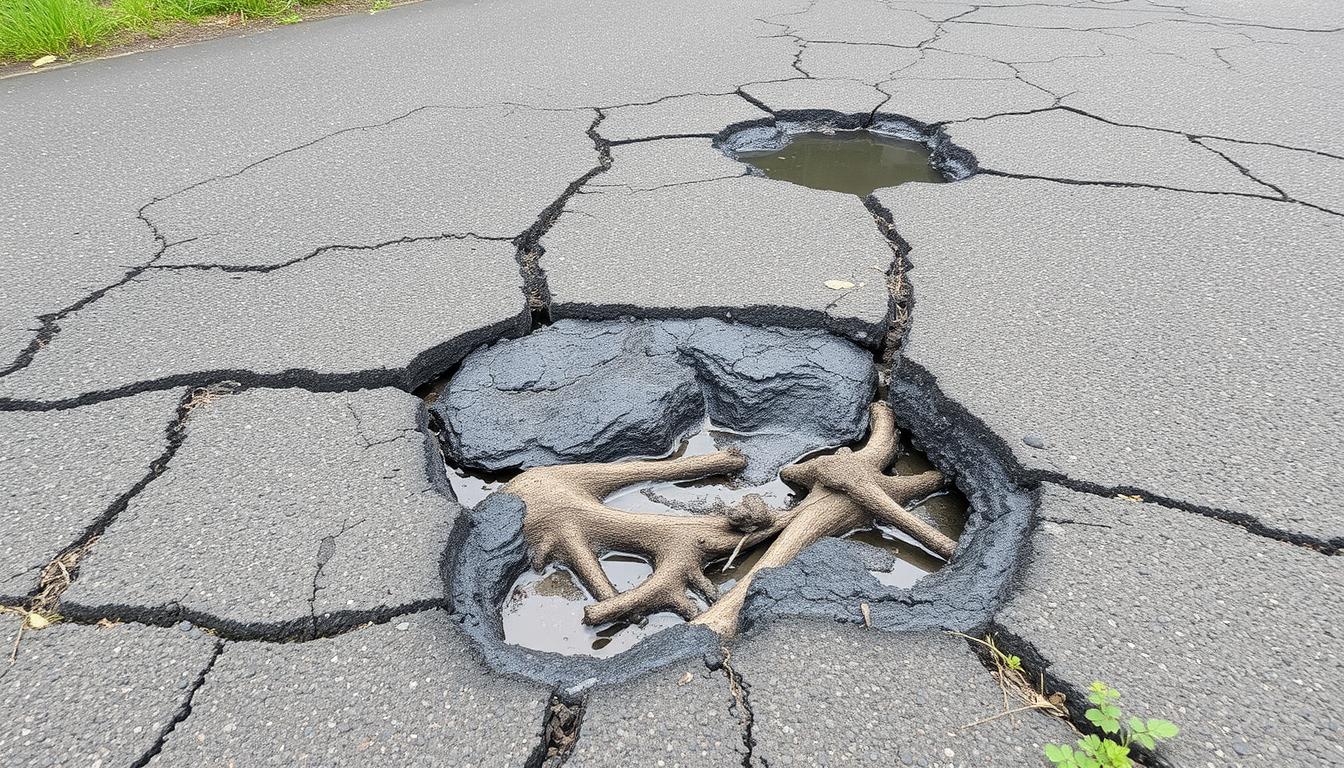Have you ever wondered What Safety Precautions Are Necessary During Asphalt Removal? This task is both critical and dangerous in construction. It demands careful attention to safety measures.
This question highlights the risks and the need for proper planning and protection. A safe work area is essential to protect workers and keep the surroundings safe. Using the right personal protective equipment (PPE) and understanding dangers are key steps.
In this article, we will explore important safety measures for asphalt removal. We will also share tips to ensure everyone’s safety during this complex process.
Key Takeaways
- Regular maintenance of asphalt surfaces can prevent deterioration and enhance property value.
- High-visibility clothing reduces accident rates significantly in work zones.
- Effective communication and training are essential for maintaining a safety culture.
- Immediate reporting of unsafe conditions can mitigate risks during asphalt removal.
- Properly preparing the worksite minimizes possible hazards from traffic and debris.
Understanding Asphalt Removal
Asphalt removal involves tearing up asphalt for repairs, replacement, or landscaping. It starts with knowing the materials, mainly aggregates and bitumen. This knowledge helps choose the best methods for the job, considering size and thickness.
What is Asphalt Removal?
Asphalt removal isn’t just for driveways. It’s also for parking lots and roads. Signs like deep cracks and uneven surfaces mean it’s time for removal. If more than 25-35% is damaged, it’s often cheaper to remove and replace it all.
Common Applications for Asphalt Removal
Asphalt removal is used for many things, like driveways, parking lots, and roads. Each project needs its own approach. Jackhammers work for tight spots, while excavators are better for big areas. Choosing the right method is key to success.
Importance of Safety in Asphalt Removal
Safety is critical in asphalt removal. Heavy machines and dangerous materials are risks. Good safety measures reduce accidents and improve work. Training workers and following safety rules keeps everyone safe.
Potential Hazards of Asphalt Removal
Asphalt removal is a challenging task that requires careful attention to safety. Workers face risks from hazardous substances, heavy machinery, and weather conditions.
Exposure to Dangerous Chemicals
Workers are at risk from asphalt chemicals. Over half a million people are exposed to asphalt fumes, which contain harmful VOCs. These can cause headaches, skin rashes, and even skin cancer.
While OSHA doesn’t have specific standards for asphalt fumes, wearing PPE is key. This includes face shields, gloves, and safety boots to protect against skin damage and harmful inhalation.
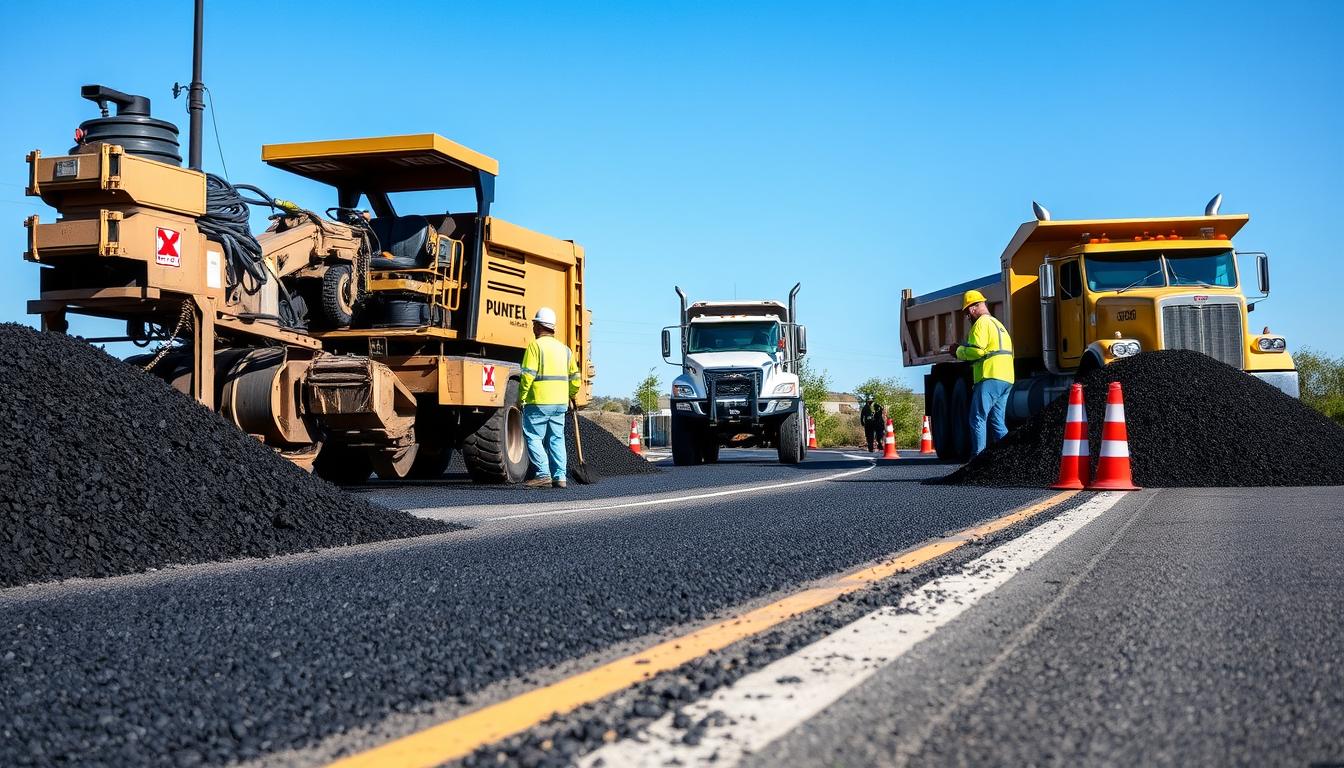
Heavy Equipment Risks
Heavy machinery like excavators and jackhammers can be dangerous. It’s important to handle them carefully to avoid accidents. Getting proper training is essential for safety.
Workers need to know the risks of machinery to prevent accidents. Regular checks on equipment can help reduce dangers.
Weather-Related Hazards
Bad weather can make asphalt removal unsafe. Rain, high winds, and extreme temperatures can make surfaces slippery. This increases accident risks. It’s important to understand these weather hazards.
Adapting work practices to weather conditions can improve safety. This helps minimize risks from environmental factors.
Essential Personal Protective Equipment (PPE)
Wearing the right protective gear is key for asphalt removal safety. Each piece of equipment helps protect against hazards. Following safety rules ensures everyone’s safety and meets legal standards.
Hard Hats and Safety Helmets
Hard hats are a must for asphalt removal workers. They protect against head injuries from falling objects and accidents. Brightly colored hard hats make workers more visible, improving site safety.
High-Visibility Clothing
High-visibility clothing is vital in crowded work areas. It helps workers be seen by machinery operators, reducing accidents. The right gear is essential, even in low-light conditions.
Respirators and Dust Masks
Respiratory protection is critical in asphalt removal due to harmful chemicals. Dust masks filter out harmful particles, preventing respiratory problems. Wearing these masks is essential during dusty tasks.
Protective Footwear
Protective footwear is vital for construction safety. It prevents slips, trips, and falls on the site. Steel-toed boots offer extra protection against impact injuries, a must for asphalt removal.
Equipment and Tool Safety
Keeping equipment safe during asphalt removal is key for both work efficiency and worker safety. Regular checks on machinery and tools are vital to avoid accidents and keep them working well. It’s important to use a machinery inspection checklist to check equipment often, keeping safety first on the job site.
Regular Inspection of Machinery
Regular checks can spot problems early, preventing bigger issues later. This not only makes equipment work better but also keeps everyone safe. All workers need to know how to spot wear and tear, follow the checklist, and report any issues right away.
Safe Operation Practices
Safe use of machinery reduces accident risks. Workers should get full training on safe equipment use. This includes staying alert and following all rules. Training should also stress the need to follow tool usage guidelines to avoid injuries.
Proper Use of Cutting Tools
Using cutting tools safely is essential to avoid injuries. Workers must learn how to handle and use tools like jackhammers and saws safely. Knowing the right cutting depth and methods, like wet and dry cutting, boosts both safety and efficiency. Keeping tools well-maintained ensures they stay safe and effective.
Site Preparation Procedures
Getting the site ready for asphalt removal is key to a safe work area. It starts with making sure no one gets in who shouldn’t. This keeps workers and the public safe. Using barricades is a big part of this.
Securing the Work Area
Keeping the work area safe means using barriers and clear signs. These steps protect people from dangers and show that work is happening. Good signs also tell people what to watch out for.
Signage and Barricade Requirements
Construction signs are vital for warning about asphalt removal dangers. They should tell about heavy machines and hazards. They also guide people and cars, reducing problems caused by the work.
Managing Traffic Flow
Managing traffic during asphalt removal is very important. It needs careful planning to keep everyone safe. Good detours and signs help keep cars away from danger zones. This makes driving safer and reduces problems at the work site.
Training and Certification Requirements
Training is key to keeping workers safe during asphalt removal. It teaches them about dangers and how to use equipment right. Good training makes job sites safer and work more efficient.
Importance of Staff Training
Training keeps workers up to date on safety rules and equipment use. Studies show it reduces accidents by 50%. It makes workers safer and more skilled, key for project success.
Certification for Hazardous Materials
Workers need special training for dangerous substances. They need certifications like the Hazardous Materials Endorsement for commercial drivers. This training helps follow local laws and keeps workers safe from harmful chemicals.
Continuous Education on Safety Protocols
Keeping up with safety rules is essential. Regular training every 6-12 months helps workers follow safety guidelines better. This keeps work environments safer as safety rules change.
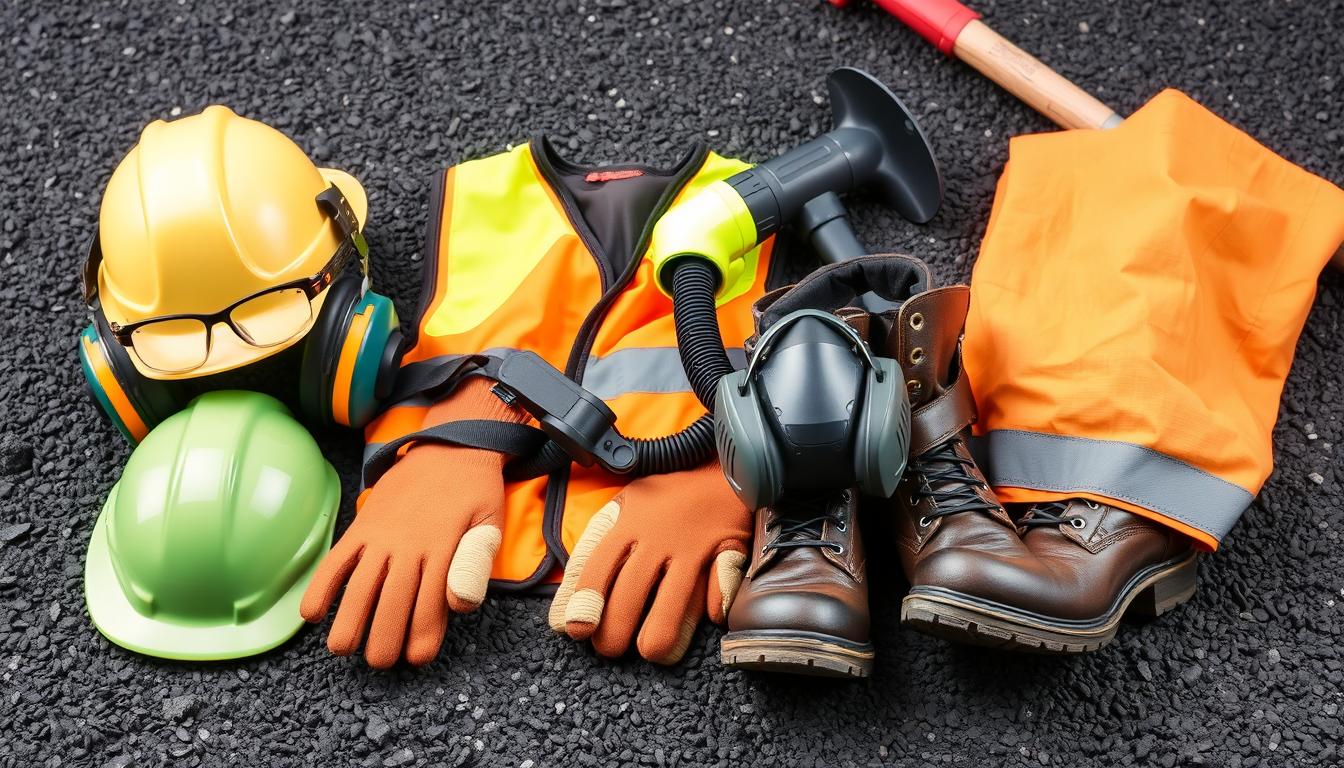
Emergency Response Plan Development
Creating a solid emergency response plan is key to keeping construction sites safe. It tells everyone their role in emergencies, leading to quick and organized action. This plan should include a detailed emergency contact list and clear evacuation steps.
Creating an Emergency Contact List
Having a current and complete emergency contact list is critical for fast communication in crises. It makes it easy to get to important help, like medical services or emergency teams. It’s important for all workers to know the list so they can act fast if needed.
First Aid Kit Accessibility
It’s important to have a fully equipped first aid kit on site for minor injuries. Regular checks on the kit ensure it’s always ready. Teaching workers basic first aid helps build a safer work environment.
Establishing Evacuation Routes
Having clear evacuation paths is vital for getting out safely in emergencies. Workers need to know these routes well. Drills and safety procedures help everyone be ready and respond quickly, keeping everyone safe.
Environmental Safety Considerations
It’s vital to focus on environmental safety when removing asphalt. Properly managing asphalt waste is key. Taking removed asphalt to recycling facilities helps local ecosystems.
Choosing the right recycling options is important. It can greatly reduce environmental harm.
Proper Handling of Asphalt Waste
Understanding and following local rules for asphalt removal is essential. Each area has its own guidelines for handling and disposing of asphalt waste. This not only protects the environment but also shows responsibility in asphalt removal.
Pollution Control Measures
Using pollution prevention measures is important in asphalt removal. Techniques like dust suppression and runoff management are critical. They help keep the environment safe.
Being aware of the risk of pollutants in water bodies is important. It leads to better practices that are safer and more sustainable.
Compliance with Local Regulations
Following local regulations for asphalt removal is key for safety and the environment. Not following these rules can lead to big fines and legal trouble. Companies that follow these rules help the industry be more responsible.
Health Risks and Mitigation
Removing asphalt comes with health risks that need careful handling. It’s important to spot workplace health hazards to keep everyone safe. Workers face dangers from harmful chemicals and dust, so we must find ways to reduce these risks.
Identifying Health Risks
Knowing the dangers of asphalt removal means understanding the chemicals in it and the risks of dust. Training is key to spotting hazards and creating safety plans. Regular checks help find and fix safety issues quickly.
Mitigating Fumes and Dust Exposure
To cut down dust in asphalt removal, we need good fume control strategies. Using PPE like respirators and good ventilation systems helps a lot. Also, using water and vacuum to control dust keeps the air clean and protects workers.
Monitoring Worker Health
Keeping an eye on worker health in construction is critical. Regular health checks can show problems from harmful materials. By monitoring health closely, companies can keep workers safe and healthy.
Worksite Safety Culture
Creating a strong safety culture at work is key, whether it’s for asphalt removal or other construction tasks. It boosts morale and cuts down on accidents. It’s important to make sure everyone feels safe to report hazards without worry.
Encouraging Open Communication
Good communication is the heart of a safe workplace. It lets everyone share safety concerns freely. Leaders should join in these talks to show they care about safety.
Reporting Unsafe Conditions
Teaching workers how to report hazards is vital. Training them to act fast when they see danger is a must. Knowing how to report unsafe spots helps keep everyone safe on the job.
Safety Meetings and Workshops
Safety meetings are key for sharing the best ways to stay safe. They keep everyone up-to-date on safety rules. Adding workshops to training programs helps workers understand and follow safety rules better. For more on building a strong safety culture, check out here.
Why Choose HT Paving and Seal Coating Services?
HT Paving and Seal Coating Services is all about safety and quality. It follows strict safety rules in every project. The company also trains its staff well to ensure top-notch work in asphalt removal and other services.
Commitment to Safety Standards
HT Paving sticks to tough safety rules to keep everyone safe. It uses special tests to make sure materials are up to standard. This careful work ensures the quality of its asphalt removal services.
Family-Owned Business Values
Being a family-owned business, HT Paving values integrity and customer happiness. These values guide how it works with clients and the community. Every project shows its commitment to quality and personal service.
Customer Satisfaction and Excellence
HT Paving aims to give clients the best results. It focuses on making customers happy with every paving job. The company’s quality checks and assurance practices improve service and build strong client relationships.
Contact HT Paving for Your Asphalt Needs
HT Paving and Seal Coating Services is ready to help with your asphalt needs in the Bay Area and nearby. We know how important reliable asphalt services are. Our team is here to offer professional help that fits your needs.
We’re always available to answer your questions about asphalt removal and seal coating quickly.
Service Areas and Availability
We’re all about excellence in asphalt projects. Need asphalt removal, seal coating, or paving solutions? HT Paving is here to help fast. Our team works hard to finish projects quickly and meet your high standards.
Get in Touch: (415) 774-6424
Ready to talk about your asphalt needs? Call HT Paving at (415) 774-6424. Our team is eager to help and share more about our services.
Overview of Services Offered
HT Paving offers a wide range of asphalt services like removal, seal coating, and paving. We aim for quality and customer happiness in every project. Our team uses the best equipment and skills to make your asphalt last longer and save on maintenance costs.
